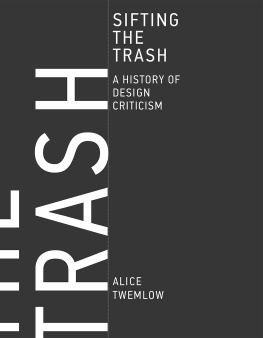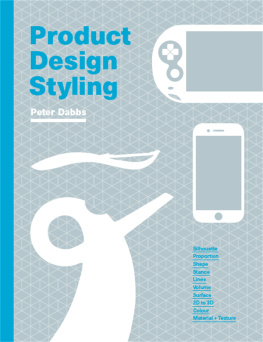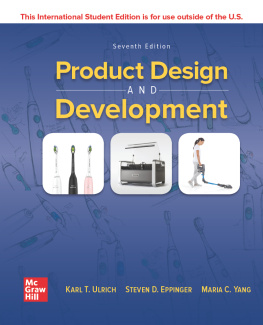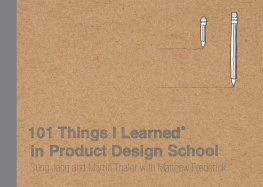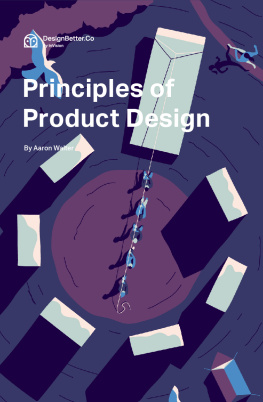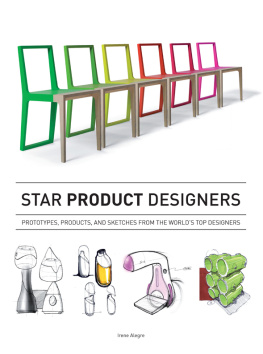Sifting
the
Trash
Sifting
the
Trash
Alice
Twemlow
The MIT Press
Cambridge, Massachusetts
London, England
2017 Massachusetts Institute of Technology
All rights reserved. No part of this book may be reproduced in any form by any electronic or mechanical means (including photocopying, recording, or information storage and retrieval) without permission in writing from the publisher.
Library of Congress Cataloging-in-Publication DataNames: Twemlow, Alice, author.
Title: Sifting the trash : a history of design criticism/Alice Twemlow.
Description: Cambridge, MA : The MIT Press, 2017. | Outgrowth of the authors thesis (doctoral--Royal College of Art, 2013) under the title: Purposes, poetics, and publics : the shifting dynamics of design criticism in the US and UK, 1955-2007. | Includes bibliographical references and index.
Identifiers: LCCN 2016034155 | ISBN 9780262035989 (hardcover : alk. paper)
Subjects: LCSH: Product design--Social aspects. | Design--Public opinion.
Classification: LCC TS171.4 .T89 2017 | DDC 658.5/752--dc23 LC record available at https://lccn.loc.gov/2016034155
EPUB Version 1.0
Acknowledgments
This book began as a PhD dissertation through the Royal College of Art/Victoria & Albert History of Design course. It was an extreme privilege to work with my supervisors, Jeremy Aynsley and David Crowley, whose research, thinking, and teaching set the gold standard for our field. I am also grateful for thoughtful input by other R C A/ V&A tutors and the students during our work-in-progress sessions.
While undertaking my doctoral studies, I was also the founding chair of the M FA in Design Criticism and the MA in Design Research, Writing & Criticism at the School of Visual Arts in New York. For this remarkable opportunity, my heartfelt thanks go to StevenHeller and David Rhodes at SVA. I am also indebted to my colleagues, students, and alumni, whose critical thinking about design deployed in all manner of modes, from the guerrilla bodega exhibition to the reality television series, continually inspires me.
This book benefits from the expertise of archivists and librarians who have facilitated archival research at the Archive of Art and Design, Bard Graduate Center library, University of Brighton Design Archives, Design Museum Archive, Getty Research Institute, Special Collections and University Archives, University of Illinois at Chicago, Institute of Contemporary Arts Archive, National Art Library School of Visual Arts library, and the University of the Arts library, among others.
I would like to express my gratitude to all the interviewees who so generously shared the insights and recollections that inform this research. They are as follows: Deborah Allen, Mary Banham, Stephen Bayley, Ralph Caplan, Claire Catterall, Sheila Levrant de Bretteville, Anthony Dunne, Simon Esterson, Richard Farson, Merrill Forde, Ken Garland, Richard Hamilton, Dick Hebdige, Mark Kingsley, Peter Murray, Eli Noyes, Rick Poynor, Fiona Raby, Deyan Sudjic, Jane Thompson, Judith Williamson, Jon Wozencroft, and Peter York.
A 2015 Production and Presentation Grant from the Graham Foundation for Advanced Studies in the Fine Arts enabled the images in this book to be sourced and licensed, and funded some color reproductions. Particular thanks go to Enya Moore, my valued research assistant, for doggedly tracking down the images, and to Sonia Mangiapane for taking some of the photographs. Among those individuals and institutions who helped me in gathering and gaining permission to publish images are: Oliver Allen, Architectural Press Archive / R I BA Collections, Mary Banham, Ralph Caplan, Nigel Coates, Design Council Archives, University of Brighton Design Archives, Design Museum, Design Curial, Dunne & Raby, F&W, Ken Garland, Graphic Thought Facility, Richard Hamilton Estate, Dick Hebdige, Alvin Lustig Archive, Mowat and Company, Peter Murray, Eli Noyes, Jane Thompson, and Armin Vit.
Two of my esteemed S VA colleagues, Adam Harrison Levy and Russell Flinchum, kindly read the manuscript in its various states of disarray, and offered helpful advice. I was also lucky enough to have Thomas Weaver, editor at the Architectural Association, and the design historian Pat Kirkham as my PhD external examiners; their insightful comments have contributed meaningfully to the final shape and complexion of this book. I would also like to thank Emily King and Rick Poynor for being my long-term, and long-distance, mentors.
Many thanks are due to Roger Conover at the M I T Press for believing in this book, and in particular to Victoria Hindley for patiently shepherding me through the process of itsproduction. I am also indebted to my skillful editor Gillian Beaumont, to Margarita Encomienda for the sensitive design of the book, and to Matthew Abbate and everyone else at MIT involved in the complex project of bringing a book to press.
Parts of chapter 2 have been published as essays in the journal Design & Culture , volume 1, number 1 (Berg, March 2009), as I Cant Talk to You if You Say That: An Ideological Collision at the International Design Conference at Aspen, 1970, and in the book The Aspen Complex , ed. Martin Beck (Sternberg Press, 2012), as A Guaranteed Communications Failure: Consensus Meets Conflict at the International Design Conference in Aspen, 1970. Special thanks to their editors, Elizabeth Guffey, Martin Beck, and Leah Whitman-Salkin, respectively.
Finally, I would like to thank my mother, Cayla Twemlow, and my father, Graham Twemlow, for their immeasurable love and support, and my wonderful husband David Womack for his guidance, humor, and patience, which have provided much-needed intellectual and emotional ballast over the many years that this project has cohabited with us. Very last of all, thanks to our son Otto Gray Womack, an informed critic of Lego, Minecraft, and playgrounds, among other aspects of the designed environment, for all the happy distraction he provides.
This book is dedicated to the design critic Deborah Allen (19242014). I am very grateful that I had the chance to interview the woman who coedited Industrial Designmagazine according to the dual measures of poetry and pragmatism, reviewed 1950s cars with such panache, took care of five children, and wrote the line hers is a lush situation. It really is. My thanks to all.
Amsterdam, 2016
Introduction
Debut and demise, purity and pollution
Design criticism operates at the very brink of the landfill site, salvaging some products from its depths, but also hastening the descent of others through its condemnation or indifference. Like the contractors and scavengers who amass, and comb through, Victorian Londons rubbish heaps in Our Mutual Friendhoping to find treasure in the Coal-dust, vegetable-dust, bone-dust, crockery dust, rough dust and sifted dust,all manner of Dust, so design curators and critics amass and comb through the looming detritus of contemporary society, temporarily arresting the progress of products on their journey from factory to junkyard, and diverting them toward a spotlit, white plinth or a glossy, double-page spread.
Criticism, as the exercise of making distinctions between things, stems from a long tradition of liberal humanist criticism, encapsulated by literary critic I. A. Richards as the endeavour to discriminate between experiences and to evaluate them or, by R. P. Blackmur, as the endless search with every fresh impulse or impression for better names and more orderly arrangements.

